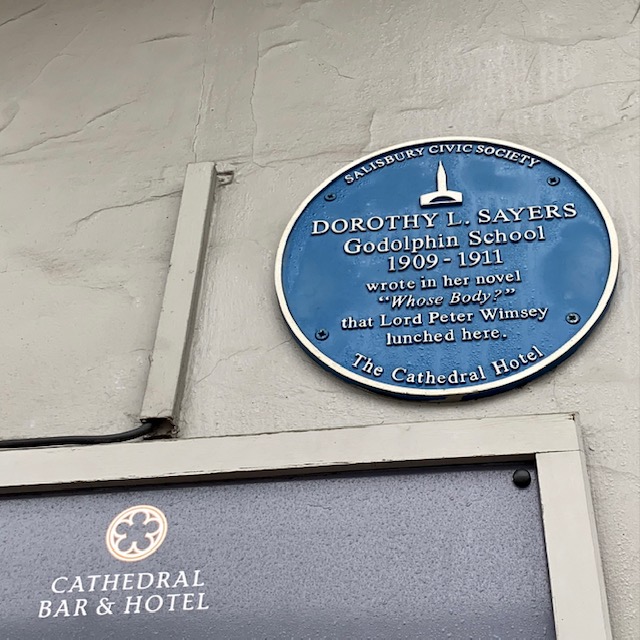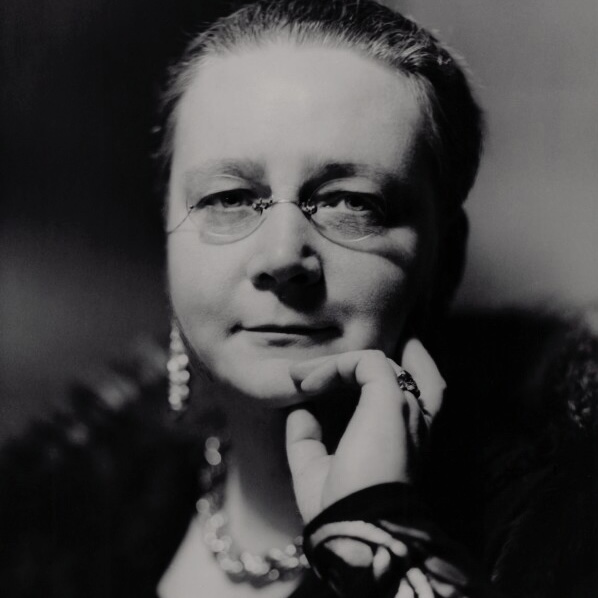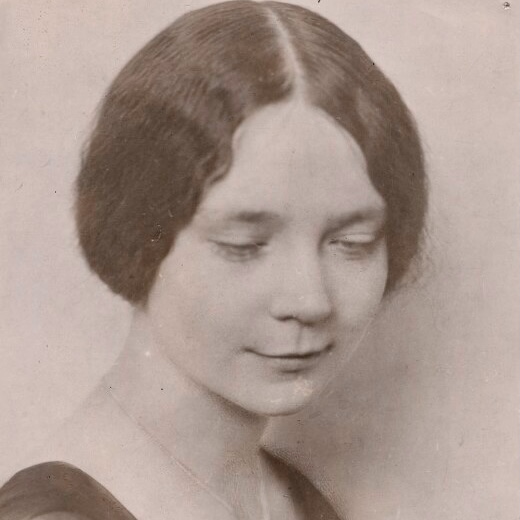Dorothy Sayers by Unknown photographer vintage print, early 1920s4 5/8 in. x 3 7/8 in. (116 mm x 99 mm) image size Given by Terence Pepper, 2013 Photographs Collection NPG x194180
Dorothy L. Sayers (1893 -1957) was a talented writer, translator, poet, dramatist, playwright and essayist, best known for her detective fiction, featuring the characters Lord Peter Wimsey and Harriet Vane. As a woman writer of her time, Sayers leaves behind a tremendous literary legacy.
Dorothy Sayers was born in Oxford in 1893 and spent her early years in Cambridgeshire. Her main link to Salisbury was her education as a boarding student at Godolphin School: the City has a blue plaque detailing this. During her school years her poetry was published in The Godolphin Gazette, the school’s magazine (1909-11).
She went on to study modern languages and medieval literature at Somerville College in Oxford. She had a good sense of humour and wit, and a penchant for wearing dramatic clothes. In 1915, she was one of the first women to graduate from the university, although at the time it was still not possible for women to be officially awarded degrees. Sayers was awarded her MA when the rules changed in 1920. After university she went on to work in publishing, copywriting and advertising before earning her living full time as a writer, by no means the norm for women of her time. Sayers work was highly respected and traversed many different genres, including poetry, fiction, plays, radio scripts, literary criticism, theology, academic works, and essays.
She is however, probably best known for her crime fiction novels, which were part of the so-called Golden Age of Detective Fiction. From 1949 to 1957 she was President of the Detection Club (a group of writers of mystery fiction, including Agatha Christie, which Sayer helped found). Her detective novels and short stories, set between the first and second World wars, feature amateur detective, Lord Peter Wimsey. In ‘Whose Body’ (1923), Lord Peter visits Salisbury as part of his investigations and features several local locations including Milford Hill, The Close, and Pennyfarthing Street. In recent years her fiction has been criticised for alleged racism and anti-semitism1, although this may be reflective of the prejudiced societal attitudes of the time.
Her personal life was turbulent and some of the more unhappy experiences of her personal life are reflected in her work3. Most significantly, in 1923 she had a son out of wedlock, kept secret for many years2. In 1926, she married Captain Atherton Fleming, a journalist, but the marriage was troubled.

Religion was important to Dorothy Sayers and a central theme throughout her work, from her poetry to her plays, and academic work. The Man Born to Be King, broadcast on BBC radio from 1941-1942) stirred controversy because of the depiction of Christ speaking Modern English. Her theological work was very influential, and in 1950 she was awarded an honorary doctorate of letters from the University of Durham. When living in London’s Bloomsbury she was a churchwarden for St Anne’s Church, Soho. In her later years she wrote theological novels (Creed or Chaos, 1947) and translated Italian poetry such as Dante’s Divine Comedy (1949 and 1955).
She spent the last years of her life in Witham, Essex, and died there in 1957: her ashes were scattered in St Anne’s Church in Soho. She is remembered with several blue plaques, a bronze statue in Witham, a school named after her (Sayers Classical Academy in Kentucky, USA), and even a minor planet (3627 Sayers, discovered in 1973).
There is a vast amount of information available about Sayers’ life and work which is beyond the scope of this project; therefore we encourage those interested to explore the sources and further reading listed below.

by Howard Coster print, 1938NPG x2324© National Portrait Gallery, London
Notes
1This point of contention has been discussed by several authors as listed in the Further Reading section below.
2 For example, it is thought by many that the character Harriet Vane, who features in several of her crime novels including Strong Poison (1930) is perhaps based in part on Sayers and some of her life experiences.
3Because Sayers was unmarried and the child’s father (Bill White) was already married to someone else, she kept the pregnancy hidden. White took the news of the pregnancy badly and abandoned Sayers and the unborn child. Incredibly, White’s wife helped Sayers by arranging for her to give birth to her son, John Anthony, in 1924 in a ‘mother’s hospital’ in the countryside. He was raised by her cousin Ivy, who was a foster carer. Although she was not able to have him living with her Sayers formally adopted John Anthony in 1935, and kept in touch through visits and letters. They had a close relationship and he knew Sayers as his ‘Cousin Dorothy’. She maintained the secret for many years. It was not officially revealed that Sayers was his biological mother until after her death, when he was listed as the sole heir of her literary estate.
Sources
Brown, Janice, 1998, The Seven Deadly Sins in the Work of Dorothy L. Sayers. Kent State University Press.
Crampton, Caroline (2020). 40. Dorothy’s Secret: Transcript. Sheddunit. https://shedunnitshow.com/dorothyssecrettranscript/ Accessed January 2021.
Curran, Jane (2009). Dorothy L Sayers’ life and loves http://news.bbc.co.uk/local/oxford/hi/people_and_places/history/newsid_8129000/8129149.stm. Accessed January 2021.
Devitt, Tim, 2010, St Anne’s Church: Soho Parish Church. http://www.sohomemories.org.uk/page_id__24.aspx?path=0p2p Accessed January 2021.
The Dorothy L. Sayers Society (n.d). About Dorothy L. Sayers. https://www.sayers.org.uk/biography Accessed January 2021.
Godfrey, Jim, 2020, Dorothy L Sayers. Pen Portrait No 19. https://www.chch.ox.ac.uk/blog/dorothy-l-sayers Accessed January 2021.
Hone, Ralph E., 1979, Dorothy L. Sayers: A Literary Biography. Kent State University Press.
Kuiper, 2020, Dorothy L. Sayers. https://www.britannica.com/biography/Dorothy-L-Sayers Accessed January 2021.
New World Encyclopaedia. (n.d.) Dorothy L. Sayers. https://www.newworldencyclopedia.org/entry/Dorothy_L._Sayers
Peschel, 2011, The complete, annotated Whose Body? By Dorothy L Sayers edited with notes and essays. Peschel Press.
Sayers, Dorothy L. and Shideler, Mary McDermott, 2005, Are Women Human? Astute and Witty essays on the role of women in society. William B. Eedermans Publishing Company.
Wikipedia, 2020, https://en.wikipedia.org/wiki/Dorothy_L._Sayers Accessed January 2021.
World Heritage Encyclopaedia (n.d.). http://www.self.gutenberg.org/articles/eng/Dorothy_Sayers#cite_note-26 Accessed January 2021.
Further reading:
List of works by Dorothy L. Sayers: https://en.wikipedia.org/wiki/List_of_works_by_Dorothy_L._Sayers
Books about Dorothy L. Sayers’ life and work:
Brabazon, James, 1981, Dorothy L. Sayers. Scribners.
Brunsdale, Mitzi M, 1991, Dorothy L. Sayers: Solving the Mystery of Wickedness. Berg Publishers.
Coomes, David, 1992, Dorothy L. Sayers: A Careless Rage for Life. Lion Books.
Dale, Alzina Stone, 2005, Dorothy L. Sayers: The Centenary Celebration.
Dale, Alzina Stone, 2003, Maker and Craftsman: The Story of Dorothy L. Sayers. iUniverse.
Downing, Crystal, 2004, Writing Performances: The Stages of Dorothy L. Sayers. Palgrave Macmillan.
Fletcher, Christine M., 2013, The Artist and the Trinity: Dorothy L. Sayers’ Theology of Work. Pickwick Publications.
Gaillard, Dawson, 1981,. Dorothy L. Sayers. F. Ungar Publishing Company.
Hitchman, Janet, 1976, Such a Strange Lady: A Biography of Dorothy L. Sayers. New English Library.
Kenney, Catherine, 1990, The Remarkable Case of Dorothy L. Sayers. Kent State University Press.
Percy, Sandra, 2010, Dorothy L. Sayers: More than a Crime Fiction Writer. Createspace.
Reynolds, Barbara, 2002, The Letters of Dorothy L. Sayers: Child and Woman of her time: Vol 5 ( A supplement to the letters). Dorothy L. Sayers Society.
Reynolds, Barbara, 1993, Dorothy L. Sayers: Her Life and Soul. St Martin’s Press.
Reynolds, Barbara, 1989. The Passionate Intellect: Dorothy L. Sayers’ Encounter with Dante. Kent State University Press.

